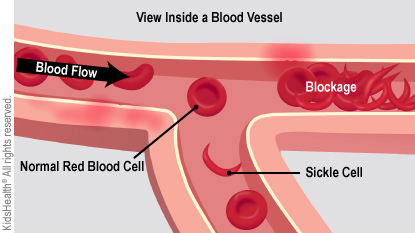Crizanlizumab for People With Sickle Cell Disease
What Is Crizanlizumab?
Crizanlizumab is a medicine that can help people who get a lot of pain crises from sickle cell disease.
The medicine works by preventing blood cells from sticking to the inside walls of blood vessels. People who take crizanlizumab have less pain and need to make fewer trips to the hospital.
What Happens in Sickle Cell Disease?
Healthy red blood cells are soft, flexible, and round. Sickle cell disease makes red blood cells become sticky, hard, and C-shaped. The sickle cells get stuck and block the blood flowing inside small blood vessels. This can be painful and lead to other problems that need to be treated in a hospital.
Sickle cells also break down more quickly than healthy red blood cells. Not having enough red blood cells can lead to anemia. People with anemia feel tired and have less energy.

How Does Crizanlizumab Help People With Sickle Cell Disease?
Crizanlizumab (pronounced: kriz-an-LIZ-uh-mab) slows or stops red blood cells, white blood cells, and platelets from sticking to each other and to the inside of blood vessel walls. People who take crizanlizumab may have fewer pain crises and spend less time in the hospital.
Who Can Take Crizanlizumab?
People 16 years or older can take crizanlizumab. Doctors are studying if it is safe for younger people.
You can take crizanlizumab whether or not you already take the medicine hydroxyurea for sickle cell disease.
What's It Like to Take Crizanlizumab?
Here are the basics of taking crizanlizumab:
- Type of medicine: It's an infusion. This means the medicine is put into a person's vein through an IV, which is a small tube. The IV is placed into the vein with a small needle, then the needle is removed, leaving the tube there. When the dose of crizanlizumab is done (after about 30 minutes), the IV is removed.
- Dose: People get it once a month at a doctor’s office, an infusion center, or the “outpatient” part of a hospital, depending on their insurance. When a person starts on crizanlizumab, they need 2 visits the first month, then a monthly visit after that.
Does Crizanlizumab Cause Side Effects?
Most people who take crizanlizumab do well and don’t notice any side effects. Possible reactions to the IV infusion include nausea, fever, pain during or just after getting the medicine. Slowing down the IV can sometimes reduce mild symptoms. Rarely, someone might have diarrhea, itching, or tiredness.
How Much Does Crizanlizumab Cost?
The amount you pay (if anything) for crizanlizumab will depend on your insurance. Ask your doctor for more information. Some programs may be able to help pay for out-of-pocket costs.
If your care team recommends crizanlizumab, talk to them about it. Ask questions and share any concerns. Talk it over with a parent or an adult you trust. Soon you’ll be ready to make a choice you can feel good about.


